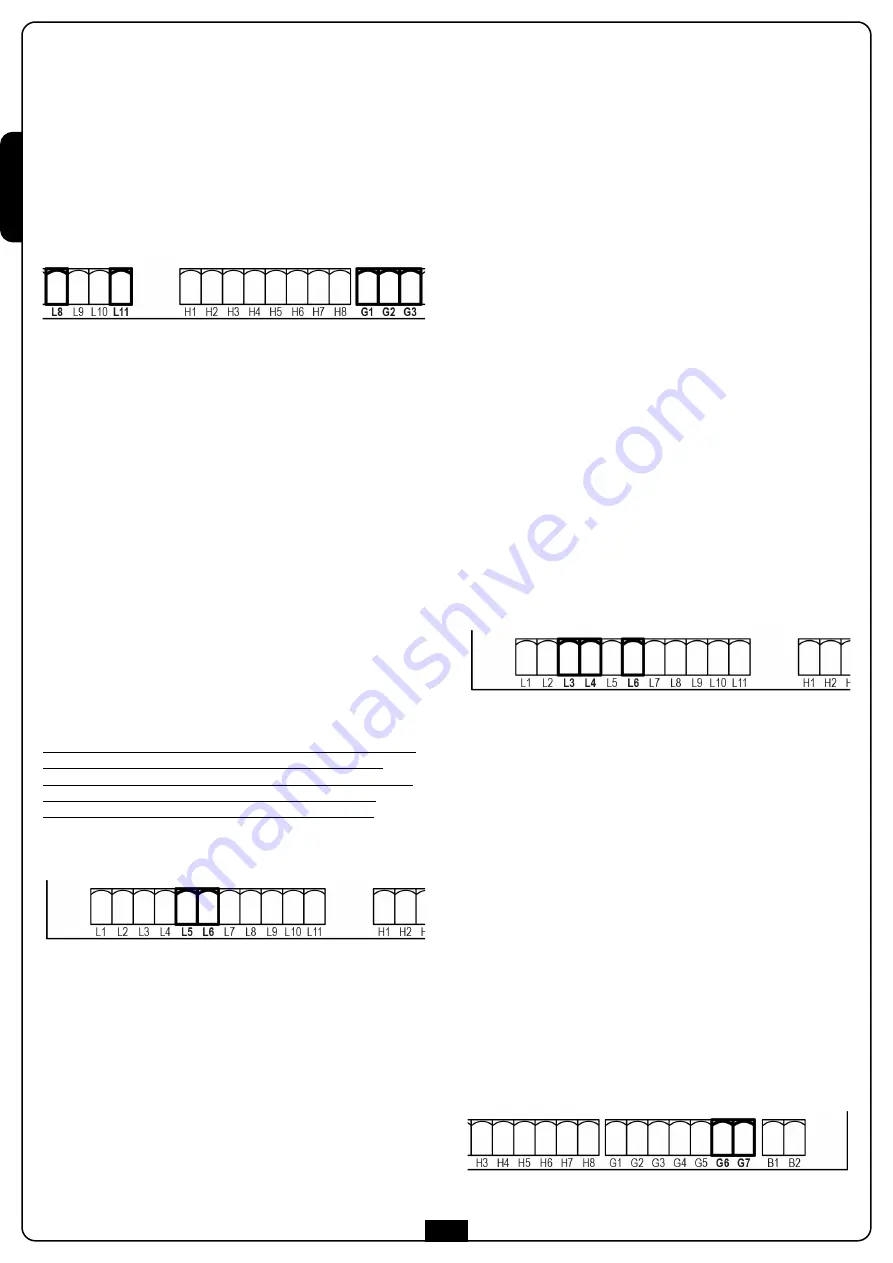
E
N
G
L
IS
H
44
SAFETY RIBBONS
They can be installed located on the anti-shock rubber bumper
strip, which normally comes provided with the boom kit.
In case of intervention during the closing, reopening and
disabling of the automatic closing occurs.
The control unit is able to carry out either the classic safety
ribbons with normally closed contact, or conductive rubber safety
ribbons with 8,2 kohm nominal resistance.
Connect the cables between terminals
L8
and
L11
of the control
unit.
m
ATTENTION:
In order to meet the requirements of the
EN12978 rules, it is necessary to install safety ribbons controlled
by a control unit continuously checking the proper working. If
using control units suited to the test by power outage, connect
the power supply cables of the control unit between terminals
G3 (+)
and
G2 (-)
of the control unit. Otherwise, connect them
between terminals
G1 (+)
and
G2 (-)
.
m
ATTENTION:
• If more safety ribbons with normally closed contact are used,
their outputs must be connected in series.
• If more safety ribbons with pressure conductive rubber are
used, their outputs must be connected in cascade style and
only the last one must be ended on the nominal resistance.
• The active edges, connected to the accessory power
supply, are not active when the control unit switches to
ENERGY SAVING mode
STOP
For greater safety it is possible to install a push-button that when
pressed causes immediate stop of the barrier. The switch must
have a normally closed contact that opens in case of set in action.
If the stop switch is set in action while the barrier is opened, the
automatic reclosing function becomes disabled; in order to
reclose the barrier it is necessary to give a start command (if the
start function in pause is disabled, it becomes temporarily
reenabled in order to allow the lock release of the barrier).
Connect the stop switch cables between cables
L5
and
L6
of the
control unit.
ACTIVATION INPUTS
The control unit has two activation inputs available,
whose functions depend on the programmed mode of operation
(See voice
Strt
on the programming menu):
•
Standard mode:
first input (START1) controls the opening,
the closing and the arrest depending on the programming
mode set.
•
Open/Close and Man Present mode:
an input command on
push-button START1 always commands the opening and an
input command on push-button START2 always commands
the closing.
In the Open/Close mode the command is of impulsive type,
that is, an impulse causes the total opening or closing of the
barrier.
In the Man Present mode, the command is of the monostable
type, that is the barrier opens or closes as long as the contact
is closed and arrests immediately if the contact becomes open.
•
Clock mode:
it is analogous to the standard mode, but the
barrier remains opened as long as the contact remains closed
on the input START1; when the contact comes opened begins
the pause countdown, which upon expiring the barrier
recloses. This function allows programming throughout the
day the opening hour cycles of the barrier, using for this an
external timer. It is indispensable to enable automatic reclosing.
m
ATTENTION: in all modes, the input commands must
be connected to devices with normally opened contacts.
Connect the cables of the device that commands the START1
input between terminals
L3
and
L6
of the control unit.
Connect the cables of the device that commands the START2
input between terminals
L4
and
L6
of the control unit.
The function associated to the START1 input command can also
be activated by pressing push-button UP from outside the
programming menu, or by means of a remote control command
memorized on channel 1 (see the instructions of receiver MRx).
The function associated to the START2 input command can also
be activated by pressing push-button DOWN from outside the
programming menu, or by means of a remote control command
memorized on channel 2 (see the instructions of receiver MRx).
LOW VOLTAGE LIGHT OUTPUT
The control unit has a 24 VDC output that allows
connection of a maximum load of 3 W.
This output can be used to connect a warning light, indicating
the status of the gate, or for a low voltage flashing light
(e.g. BLINKO-24V).
Connect the low voltage signal light or flashing light wires to
terminals
G6 (+)
and
G7 (-)
.
CAUTION: Pay attention to the polarity of the connected
device if necessary.
Summary of Contents for 36A004
Page 2: ......
Page 9: ...ITALIANO 7 Fig 3...
Page 11: ...ITALIANO 9...
Page 16: ...ITALIANO 14...
Page 34: ...ITALIANO 32 INSTALLAZIONE DELL ACCESSORIO 163604...
Page 41: ...ENGLISH 39 Fig 3...
Page 43: ...ENGLISH 41...
Page 48: ...ENGLISH 46...
Page 66: ...ENGLISH 64 INSTALLATION OF THE ACCESSORY 163604...
Page 73: ...FRAN AIS 71 Fig 3...
Page 75: ...FRAN AIS 73...
Page 80: ...FRAN AIS 78...
Page 98: ...FRAN AIS 96 INSTALLATION DE L ACCESSOIRE 163604...
Page 105: ...ESPA OL 103 Fig 3...
Page 107: ...ESPA OL 105...
Page 112: ...ESPA OL 110...
Page 130: ...ESPA OL 128 INSTALACI N DEL ACCESORIO 163604...
Page 131: ......
Page 132: ......

































